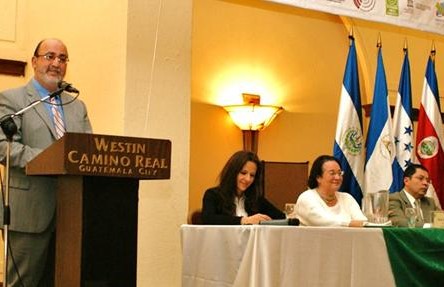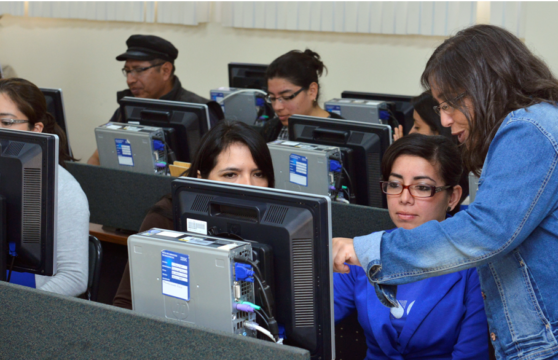
Improving the Teaching Profession in Guatemala
Links to agenda and media coverage of a conference on the state of the teaching profession in Guatemala.
This post is also available in: Spanish
The Covid-19 pandemic has revealed how urgent it is to have a high-quality teaching body that responds to the new pedagogical demands. In this scenario, the sustained decrease in the number of teachers has established a relevant challenge to achieve the objective of improving learning in the region. The conditions of educational management and policy, if maintained in their current state, could exacerbate the problem of the shortage of effective teachers.
This blog is complementary to the event Opportunities for Renewal in the Teaching Staff. It includes an interview with Verónica Cabezas, president of the board of Elige Educar and an academic from the Department of Educational Theory and Policy at Pontificia Universidad Católica de Chile’s Faculty of Education.
Question (Q): Tell us about the study you conducted in your country. What was the process, and how did you carry it out? What were the main messages or findings of the study?
Response (R): The projections presented are part of the most recent update of a study carried out with public and private databases (associated with admission processes) of the Chilean educational system, which allows us to calculate and project both the need and availability of teachers in each subject and region of the country. The information used includes school enrollment at each level of education* and grade**, average class size, and population projection, which allows us to identify how many boys and girls will enter compulsory education each year. Enrollment in teaching careers is also used, considering future increases in selectivity for entry and the rate of employability, attrition, and teacher retirement. We also consider the teaching hours in front of the classroom established by law for teachers, among other variables.
The findings of our research team (from Elige Educar) indicate that if the conditions are maintained and the challenge is not addressed, in Chile by 2025, there will be a deficit of 26 thousand qualified teachers, that is, teachers trained in the respective discipline required. This represents 19 percent of the teachers that will be needed in the country in the coming years, so it’s necessary to strengthen the teaching profession to reduce dropout rates and attract more young people to train as teachers, among other measures.
*Educational level refers to the existing division between grades according to the students’ curriculum. In this study, the basic level (1st to 8th Grade) and middle school (1st to 4th Grade) were considered.
**Grade refers to each course that makes up each level. The basic level has 8 grades (1st to 8th Grade), and the middle level has 4 (1st to 4th Grade).
(Q): What can be the role of civil society organizations in collecting this important data and/or collaborating with the public sector for its analysis and dissemination?
(R): In the region, there are great demands in the educational system. To address each of these issues, Civilian Social Organizations (CSOs) have an important role in, for example, collaborating with academia and the public sector to gather new information that will allow the construction of a roadmap for the improvement of education systems in direct contact with the educational communities. Based on these needs and desires, CSOs can propose methodologies, articulate actors, contribute diverse perspectives to analyze information, and propose solutions. Comparative studies also make it possible to identify gaps in the systematization, availability, and access to information.
In addition to analyzing and disseminating the results, advocacy can lead to important spaces for collaborative work with the public sector. In the case of our study, the findings and problematization gave way to a working group convened by the Ministry of Education to attract young people to teaching careers, with the participation during 2019 and 2020 of ministerial representatives, universities, and civil society.
(Q): What factors, besides retirement, affect the dropout or retirement from the teaching profession? What can countries do to respond to these factors?
(R): Research highlights that the abandonment of teaching for reasons other than retirement is related, among other factors, to the de-professionalization that teachers perceive in their work and the lack of autonomy, job dissatisfaction with the lack of support and resources, and work overload, and low salaries. A relevant fact is that, in Chile, as in other countries, retirement and turnover are higher in the first years of the profession, so effective accompaniment in the labor insertion is key. In this sense, mentoring can help contextualize learning with a teacher trained to be a mentor to allow the youngest teachers to get off to a good start in the teaching profession.
Also, and transversally in the system, fostering teacher autonomy is relevant to advance in the valuation of teachers as education professionals. Together with the above, professional learning communities with classroom observation practices and formative feedback can be good elements to consider.
(Q): How much room is there to renew teaching (with the hiring of new teachers) without causing massive disruptions?
(R): A first step is to have clear, systematized, and updated information on how many teachers are working in schools and how many leave the classroom each year, due to retirement, to another role in the education system, or leave it altogether, and how many enter as new teachers. This, coupled with teacher need, will shed light on the size of the challenge of teacher turnover.
With this information and its follow-up over time, measures can be designed to move towards harmonious recruitment of teachers, which also takes into account territorial needs, particularly in isolated communities or those with greater socioeconomic vulnerability. It’s also important to link these decisions to public policy decisions, such as increasing coverage or making education levels compulsory, to the capacity to train and retain teachers.
One characteristic of the teacher labor market that has not been studied in depth is the reentry of teachers into the educational system who left the profession in previous years. Another study we are currently developing on teacher retention, turnover, and reentry using a longitudinal database of teachers in Chile, shows that 50 percent of teachers who leave the classroom from one year to the next return to the classroom. In other words, they represent a relevant potential source of teacher supply that could help educational systems to meet their requirements for quality teachers. Studying the factors associated with their departure and subsequent reentry and how these are connected can be a source of valuable information for re-recruiting teachers with experience, training, and vocation.
(Q): What aspects should education systems in the region prioritize in order to address the high demand for qualified teachers?
(R): It’s essential to improve the attractiveness of the profession, which implies working on the autonomy and professional development of teachers, ensuring better working conditions, along with promoting managerial leadership that enables teachers to carry out their work in a dynamic environment that allows them to innovate and work with all their skills and abilities. In this way, progress can be made in attracting students with vocation and good academic performance to education careers, as well as in retaining practicing teachers and developing pedagogical talent in each of the countries.
On the other hand, it’s necessary to innovate in the ways of recruiting to the profession, understanding that teachers’ training and career paths may be diverse. It is important, therefore, not only to work on recruitment programs (with information on financial and non-financial benefits) for secondary school students but also to focus on late vocations, on professionals from other disciplines who, with a shorter training period and adequate support, can become secondary school teachers.
Also, considering early childhood educators, programs for continuing studies should be strengthened for those who already have a technical degree in education, and continuous in-service training programs should be strengthened. This program should include theoretical and practical training, as well as mental health support and a focus on teacher wellbeing.
The demand for teachers will increase in the coming years, and post-pandemic times require us to be able to understand the adjustments that have taken place in the world of work globally, not only in education. We know that pecuniary benefits, such as salary, are relevant in recruiting and retaining qualified teachers, but human psychological factors are also key. For example, a recent study shows that teachers during the pandemic were less likely to experience a diminished sense of success when they worked in schools with strong communication, targeted training, meaningful collaboration, fair expectations, and authentic recognition during the pandemic.
(Q): We know that the issue of teacher staffing is not just a matter of demographics but quality as well. What should governments consider when making this kind of effort to ensure the recruitment of effective teachers?
(R): Because of the implications that an effective teacher can have, models of teacher effectiveness have emerged in different countries, based on empirical studies, which seek to guide in detail what an effective teacher must do to achieve significant learning in their students. In this line, standards for initial training and for the exercise of the profession (which also have a logic of trajectory and continuity), as designed by Chile and other Latin American countries, are key to framing the training, the necessary support in the exercise, feedback, and pedagogical leadership in schools.
Along the same lines, work must be done to strengthen initial teacher training to promote the correct development of didactic and disciplinary knowledge and tools that teachers will have in future classrooms. An initial training that fosters innovation, the capacity to reflect on their own practice, and allows them to broaden the options for their teaching careers.
The hiring processes themselves are also apparently relevant in attracting effective teachers. It is important to have processes that provide information on the different employment possibilities, their working conditions, and information on the organizational culture, among other variables. In this sense, it would be important for governments to design a centralized, easy-to-navigate information system that allows current and potential teachers to learn about existing options.
Finally, to maintain the teaching effectiveness of those working in the classroom, it is essential to have schools that are places of development that encourage collaborative work among teachers, allow and promote innovation, and accompany those who are starting in teaching. The focus should be on professional development from an integral and collaborative perspective.
ONLINE EVENT: Opportunities for Renewal in the Teaching Staff
The Latin American Coalition for Teaching Excellence
Policies for Teaching Excellence: A Regional Agenda
Links to agenda and media coverage of a conference on the state of the teaching profession in Guatemala.
Using Information and Communications Technologies (ICTs) in the classroom.
Focus on teacher evaluations and professional standards in the Third Annual International Summit on the Teaching Profession.

